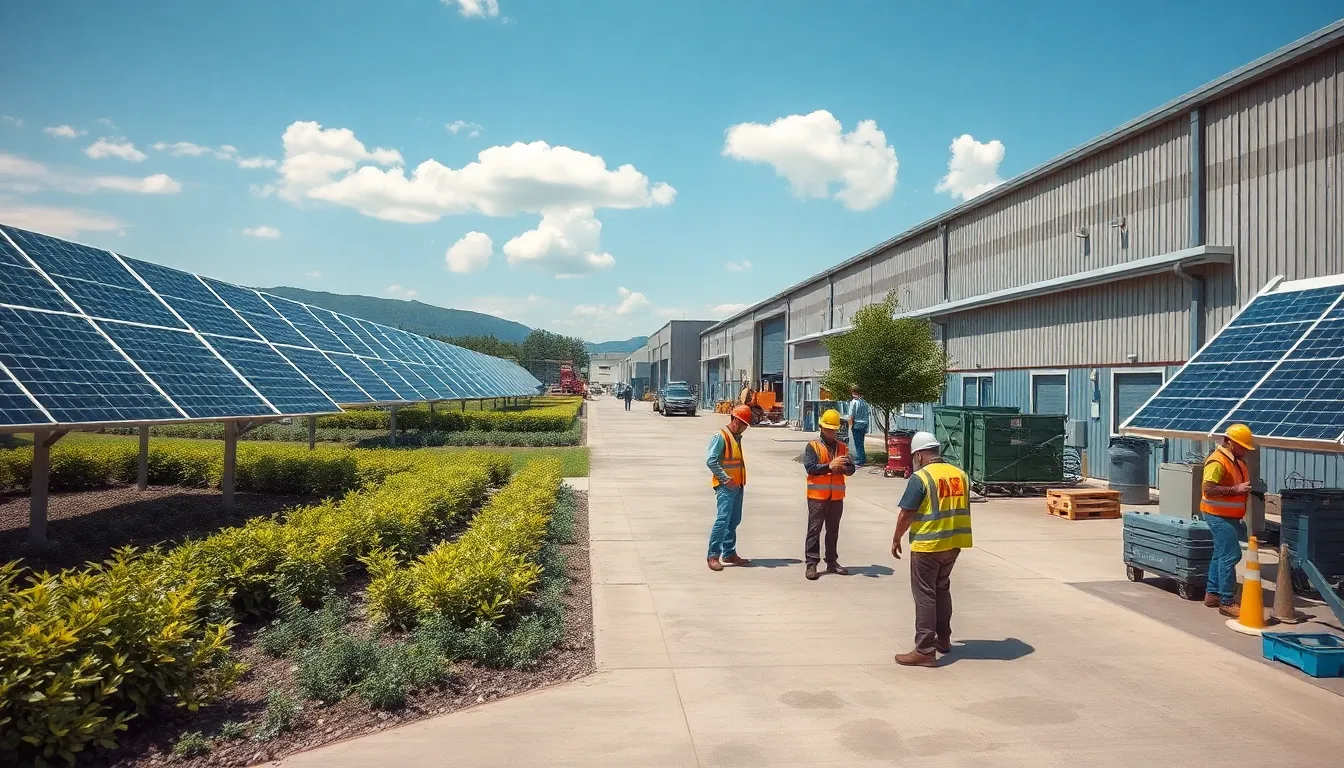Table of Contents
ToggleIn a world where climate change is the ultimate party crasher, net zero emissions are the VIP pass to a sustainable future. Imagine a planet where the air is fresh, the ice caps aren’t melting, and polar bears can chill without worrying about their next swim. Achieving net zero emissions isn’t just a lofty goal; it’s a necessity if we want to keep our planet from becoming a giant sauna.
Understanding Net Zero Emissions
Net zero emissions denote a balance between the greenhouse gases emitted and those removed from the atmosphere. Achieving this balance is crucial for mitigating climate change impacts.
Definition and Importance
Net zero emissions define a state where an entity, such as a country or corporation, achieves zero net emissions of greenhouse gases. This target holds significant importance as it addresses global warming. By reaching net zero, nations contribute to climate stability, reducing the risks of severe weather events, rising sea levels, and biodiversity loss. Aiming for this target fosters an environment where society can thrive alongside nature, promoting sustainable practices across sectors.
Key Concepts and Terminology
Understanding net zero emissions involves key concepts like carbon footprint and greenhouse gases. Carbon footprint quantifies the total greenhouse gases produced directly or indirectly by an activity. Greenhouse gases include carbon dioxide, methane, and nitrous oxide. Concepts also cover mitigation strategies, such as renewable energy and energy efficiency. Utilizing renewable sources like solar or wind helps reduce reliance on fossil fuels. Energy efficiency encourages less energy consumption while maintaining performance, crucial for achieving net zero aspirations.
Strategies for Achieving Net Zero Emissions

Various strategies contribute to the effort of achieving net zero emissions. These approaches focus on reducing greenhouse gas emissions while enhancing sustainability practices.
Renewable Energy Solutions
Adopting renewable energy sources plays a vital role in decreasing reliance on fossil fuels. Solar power generated 13% of the US electricity in 2022, showcasing significant growth in this sector. Wind energy, contributing 9%, continues to increase annually, further diversifying the energy mix. Hydropower remains a dominant player, accounting for 37% of the nation’s renewable energy. Integrating these solutions results in lower carbon emissions and fosters a cleaner energy landscape.
Energy Efficiency Improvements
Improving energy efficiency directly reduces energy consumption across various sectors. Upgrading to energy-efficient appliances can cut energy use by 20-50% compared to conventional models. Implementing smart building technologies allows for more effective monitoring and adjustment of energy usage. Transportation efficiency is equally important, with advancements in electric vehicles reducing emissions substantially. Investing in energy management systems creates lasting benefits for both the environment and economic savings.
Carbon Capture and Storage
Carbon capture and storage (CCS) technologies are essential for mitigating emissions from industrial processes. Capturing up to 90% of carbon dioxide produced, these systems minimize the release of greenhouse gases into the atmosphere. The process involves transporting the captured CO2 to storage sites, where it remains sequestered indefinitely. Notably, large-scale CCS plants, like the Boundary Dam in Canada, demonstrate its potential for significant emission reductions. Implementing CCS in coal and gas power plants can substantially contribute to achieving net zero emissions.
Challenges in Reaching Net Zero Emissions
Achieving net zero emissions presents several challenges that can hinder progress.
Economic and Financial Barriers
High costs often deter investments in renewable technologies. Financial institutions may lack the willingness to fund initiatives that promote sustainability due to perceived risks. Certain countries may face economic constraints, complicating the transition to cleaner energy sources. Tight budgets particularly affect developing nations, limiting access to necessary technologies and expertise. Additionally, technologies that support emissions reduction require upfront investments, which can be a barrier for many businesses.
Technological Limitations
Existing technologies may not suffice to meet net zero targets. Current methods for carbon capture and storage often prove expensive and complex to implement. Efficiency gains in industrial processes lag behind expectations, leaving significant emissions unaddressed. Renewable energy solutions sometimes face limitations in scalability, particularly in regions lacking infrastructure. Some technologies, like advanced battery systems, remain in early development stages, preventing widespread adoption.
Policy and Regulatory Issues
Weak or inconsistent policies create uncertainty for businesses pursuing net zero goals. Regulatory frameworks often lack clarity, complicating compliance for companies. Governments may struggle to balance economic growth with environmental responsibilities, leading to insufficient support for clean energy initiatives. Additionally, international agreements may face challenges in enforcement, resulting in varied commitments among nations. Without robust regulatory environments, achieving net zero emissions becomes more difficult.
Global Efforts and Initiatives
Global efforts to achieve net zero emissions involve various international agreements and country-specific strategies. These initiatives aim to create a collective response to climate challenges.
International Agreements and Protocols
International efforts play a critical role in the drive towards net zero emissions. The Paris Agreement, adopted in 2015, mandates countries to limit global warming to well below 2 degrees Celsius while pursuing efforts to keep it under 1.5 degrees Celsius. Following that, the Glasgow Climate Pact reinforces commitments for reduced emissions, emphasizing the need for transparency and accountability among nations. Regular summits foster cooperation among governments, allowing them to share best practices and set emission reduction targets. Furthermore, the Kyoto Protocol established legally binding obligations for developed countries to reduce greenhouse gas emissions. Overall, these agreements form the backbone of global cooperation for a sustainable future.
Country-Specific Case Studies
Countries around the world implement diverse strategies to achieve their net zero goals. Sweden aims for net zero emissions by 2045, pursuing aggressive climate policies that include significant investments in renewable energy and carbon-neutral technology. The United Kingdom targets net zero by 2050, implementing measures such as expanding offshore wind capacity and promoting electric vehicles. New Zealand achieved one of the world’s first net zero emissions legislation, requiring significant emissions cuts by 2030. Each of these case studies illustrates unique pathways to carbon neutrality, showcasing the importance of tailored approaches that align with national contexts and resources.
The Future of Net Zero Emissions
The future of net zero emissions hinges on technological advancements and community engagement. Innovations promise to reshape the approach to carbon neutrality.
Innovations on the Horizon
Game-changing technologies emerge to facilitate the shift towards net zero emissions. Researchers focus on developing improved carbon capture and storage systems that can exceed current capabilities. Additionally, breakthroughs in energy storage can enhance the efficiency of renewable energy sources, making them more reliable. Innovations in sustainable agriculture also hold potential for reducing greenhouse gas emissions. For instance, precision farming techniques help optimize resource use and minimize waste. Lastly, investments in electric vehicle infrastructure support a transition from fossil fuels to cleaner alternatives.
The Role of Individuals and Communities
Community participation plays a crucial role in achieving net zero emissions. Individuals can make impactful choices by adopting sustainable practices like reducing waste, conserving energy, and supporting local green initiatives. Grassroots movements often drive change, encouraging governmental and corporate accountability. Neighborhoods that invest in renewable energy projects demonstrate the power of collective action. Public awareness campaigns further educate residents about the importance of net zero goals, fostering a culture of sustainability. Engaging in discussions about environmental policies can strengthen community efforts toward carbon neutrality.
Achieving net zero emissions is a pivotal goal for safeguarding the planet’s future. It requires a concerted effort from individuals, businesses, and governments alike. By embracing renewable energy and enhancing energy efficiency, society can significantly reduce its carbon footprint.
Overcoming the challenges posed by economic barriers and technological limitations is essential for progress. Moreover, international cooperation and robust policies will pave the way for successful implementation of net zero strategies.
As communities rally together to adopt sustainable practices, the vision of a cleaner, healthier environment becomes increasingly attainable. Through innovation and collective action, the path to net zero emissions can lead to a sustainable future for generations to come.







